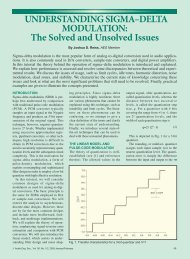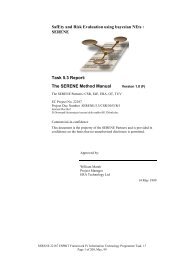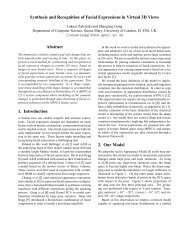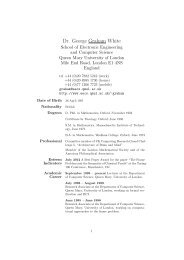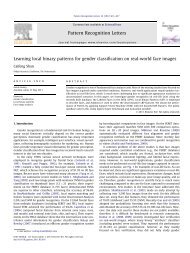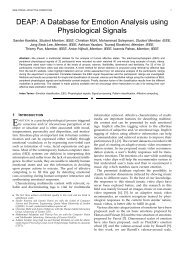Modelling an Air Traffic Control Environment Using Bayesian Belief ...
Modelling an Air Traffic Control Environment Using Bayesian Belief ...
Modelling an Air Traffic Control Environment Using Bayesian Belief ...
You also want an ePaper? Increase the reach of your titles
YUMPU automatically turns print PDFs into web optimized ePapers that Google loves.
• The use of highly skilled <strong>an</strong>d trained air traffic controllers.<br />
• The use of collision warning systems such as the Short Term Conflict Avoid<strong>an</strong>ce system<br />
(STCA) <strong>an</strong>d the <strong>Traffic</strong> Alert <strong>an</strong>d Collision Avoid<strong>an</strong>ce System (TCAS).<br />
• The skills of the pilots themselves.<br />
Despite the care <strong>an</strong>d attention devoted to the design of such a complex socio-technical system<br />
there is always a risk that a collision will occur. Recent events such as the mid air collision<br />
between a TU154 of Bashkiri<strong>an</strong> <strong>Air</strong>lines <strong>an</strong>d a Boeing 757 operated by DHL over Ueberlingen on<br />
the 1 st July 2002 illustrates the reality of such risks.<br />
In order to better underst<strong>an</strong>d the nature of the collision risk involved in <strong>an</strong> ATC environment it is<br />
necessary to have a model showing the me<strong>an</strong>s taken to avoid collisions <strong>an</strong>d via this model<br />
identify possible factors that might arise <strong>an</strong>d lead to <strong>an</strong> accident. The model adopted for this<br />
exercise is a barrier model, sometimes referred to as a “defence-in-depth” model (ref. 7). This<br />
model depicts a number of defences, which collectively aim to prevent accidents arising.<br />
In order for a collision to occur various “events” must take place. The aircraft must have been on<br />
a collision course, the automated collision warning systems must have failed in some way, air<br />
traffic control staff must have failed to note the collision trajectory <strong>an</strong>d rectify matters <strong>an</strong>d the<br />
crew of the aircraft must have failed to detect <strong>an</strong>d avoid the collision. Thus, when accidents do<br />
arise they c<strong>an</strong> be seen as resulting from the breach of a number of defences.<br />
Figure 2 shows a schematic of the barrier model taken as the starting point on this project. The<br />
first barrier is the design of the airspace the intent of which is to ch<strong>an</strong>nel aircraft in such a way<br />
that they are kept apart, <strong>an</strong>d to minimise the risks associated with crossing points where corridors<br />
meet (density <strong>an</strong>d complexity). As well as serving safety objectives air space design has to serve<br />
economic <strong>an</strong>d efficiency requirements as well.<br />
<strong>Traffic</strong><br />
Dem<strong>an</strong>d<br />
Potential<br />
Conflict<br />
B<br />
A<br />
R<br />
R<br />
I<br />
E<br />
R<br />
<strong>Air</strong>space Design<br />
Flow M<strong>an</strong>agement<br />
Pl<strong>an</strong>ner De-confliction<br />
Procedural De-confliction<br />
Projected<br />
Conflicts<br />
B<br />
A<br />
R<br />
R<br />
I<br />
E<br />
R<br />
ATC Tactical De-confliction<br />
Figure 2: Schematic Barrier Model<br />
Loss<br />
of<br />
Separation<br />
B<br />
A<br />
R<br />
R<br />
I<br />
E<br />
R<br />
ATC Recovery<br />
Pilot Recovery<br />
Providence<br />
Accident<br />
Given a designed airspace, <strong>an</strong>d given the dem<strong>an</strong>ds of airlines <strong>an</strong>d airports upon that airspace,<br />
flight pl<strong>an</strong>ners have the task of assigning flight-paths to aircraft. They may take more or less<br />
cognis<strong>an</strong>ce of the risks arising from the combination of routes they assign.<br />
Flow m<strong>an</strong>agement is a function of air traffic control which, given warning of upcoming flightpl<strong>an</strong>s,<br />
aims to maintain the volume of traffic though the various ATC sectors within m<strong>an</strong>ageable<br />
levels, so called “target sector flows”.




